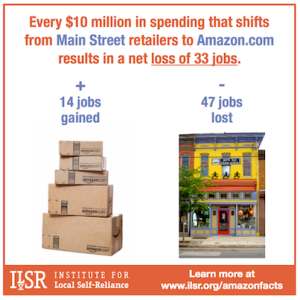- Categories:
The True Impact of Amazon on Job Creation
The Institute for Local Self-Reliance (ILSR) has created a list of five facts about Amazon’s true economic impact on communities across the country that Main Street businesses can use when talking to the media about President Obama’s speech on job growth at the Amazon warehouse in Chattanooga, Tennessee, this week.
 The information, compiled by ILSR Senior Researcher Stacy Mitchell, offers statistics that debunk the perception that Amazon acts as a job creator and positively impacts the United States economy.
The information, compiled by ILSR Senior Researcher Stacy Mitchell, offers statistics that debunk the perception that Amazon acts as a job creator and positively impacts the United States economy.
In “The Truth about Amazon and Job Creation,” Mitchell said, “The future Amazon has in mind for our country is a far cry from the middle class prosperity President Obama has been seeking. A better place to look would be along Main Street, among the new generation of independent businesses, small-scale manufacturers, local food producers, and others that are beginning to chart a much more viable path from here to there.”
Below are some of the highlights from Mitchell’s piece. For the full article, which offers links to a number of supporting documents and websites, visit Ilsr.org.
- “Amazon destroys more jobs than it creates.” Brick-and-mortar stores employ 47 people for every $10 million in sales, and 52 jobs for every $10 million when excluding chain stores. Amazon employs 14 people per $10 million.
- “Most Amazon jobs are awful.” Difficult working conditions have been detailed and documented in Amazon facilities both the United States and abroad.
- “Amazon pilfers value created elsewhere in the economy.” Amazon encourages “showrooming,” where customers browse and try out merchandise in a brick-and-mortar store, only to ultimately purchase products online. With the shuttering of independent retailers, consumers lose the opportunity to see products in real life.
- “Amazon drains dollars from local economies.” For every $100 spent at an independent retailer in a local community, $45 remains in that community; for every $100 given to Amazon, pennies are kept in that community.
- “Amazon costs taxpayers.” Amazon is receiving tax incentives, rebates, and subsidies to expand its distribution services, and also enjoys the luxury of not having to collect sales tax in many states in the country.

